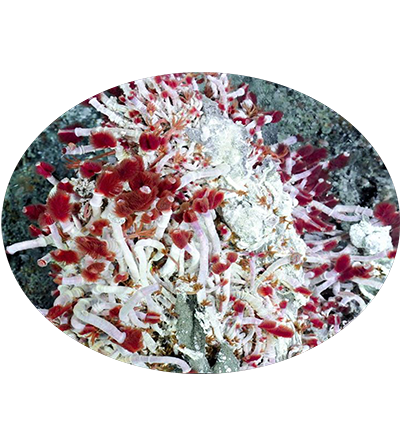
Ridgeia piscesae is a tube worm found in a variety of environments on the Juan de Fuca Ridge. Found in clusters up to several square meters in area, these Polychaete’s lack a digestive tract, instead taking up organic carbon from symbiotic, chemoautotrophic bacteria found in their specially-evolved trophosomes. These bacteria oxidize sulfur in order to create organic material. Initially thought to be several species of the Ridgeia genus on the Juan de Fuca Ridge, genetic comparison showed that only one species existed, with various morphologies. The two extreme morphologies are the so-called long-skinny and fat-short forms.
| Species | Phylum | Common Name | Ecosystem | Depth | Habitat | NCBI Taxonomy ID |
|---|---|---|---|---|---|---|
| Ridgeia piscesae | Annelida | tube worms | Hydrothermal vent | 2,196 | the Juan de Fuca Ridge (47°57.00′ N, 129°5.82′ W) | 27915 |
| Genome Assembly | Genome Size | Assembly level | Released year | WGS accession | Submitter | BioProject | BUSCO completeness | Gene Number |
|---|---|---|---|---|---|---|---|---|
| R07B-5 | 658.2Mb | Contig | 2022 | JAODUO01 | Universite de Montreal | PRJNA786438 | 94% | 31,703 |
| ASM2569855v1 | 574.96Mb | Scaffold | 2022 | JALOCR01 | Third Institute of Oceanography, Ministry of Natural Resources, PRC | PRJNA826206 | 91.70% | 24,096 |
| Title | Journal | Pubmed ID |
|---|---|---|
| Third-Generation Sequencing Reveals the Adaptive Role of the Epigenome in Three Deep-Sea Polychaetes | Molecular Biology and Evolution | 37494294 |
| The genome of a vestimentiferan tubeworm (Ridgeia piscesae) provides insights into its adaptation to a deep-sea environment | BMC Genomics | 36774470 |
| Gene ID | Description |
|---|---|
| KAK2175706.1 | - |
| KAK2175707.1 | |
| KAK2175708.1 | |
| KAK2175709.1 | TRANSCRIPTION ELONGATION FACTOR B POLYPEPTIDE 2 |
| KAK2175710.1 | |
| KAK2175711.1 | |
| KAK2175712.1 | LEISHMANOLYSIN-LIKE PEPTIDASE |
| KAK2175713.1 | |
| KAK2175714.1 | LEISHMANOLYSIN-LIKE PEPTIDASE |
| KAK2175684.1 | |
| KAK2175685.1 | |
| KAK2175686.1 | |
| KAK2175687.1 | |
| KAK2175688.1 | |
| KAK2175689.1 | |
| KAK2175666.1 | TRANSCRIPTASE, PUTATIVE-RELATED-RELATED |
| KAK2175667.1 | |
| KAK2175668.1 | OS10G0105400 PROTEIN |
| KAK2175669.1 | OS10G0105400 PROTEIN |
| KAK2175670.1 | STANNIOCALCIN |
| KAK2175671.1 | |
| KAK2175672.1 | |
| KAK2175673.1 | OS10G0105400 PROTEIN |
| KAK2175674.1 | REVERSE TRANSCRIPTASE DOMAIN-CONTAINING PROTEIN |
| KAK2175675.1 | |
| KAK2175676.1 | OS10G0105400 PROTEIN |
| KAK2175677.1 | |
| KAK2175678.1 | OS10G0105400 PROTEIN |
| KAK2175679.1 | |
| KAK2175680.1 | |
| KAK2175681.1 | |
| KAK2175682.1 | REVERSE TRANSCRIPTASE DOMAIN-CONTAINING PROTEIN |
| KAK2175683.1 | |
| KAK2175659.1 | |
| KAK2175660.1 | |
| KAK2175661.1 | |
| KAK2175662.1 | |
| KAK2175663.1 | ANKYRIN REPEAT FAMILY PROTEIN |
| KAK2175664.1 | SERINE/THREONINE-PROTEIN KINASE 17 |
| KAK2175665.1 | KRAB AND ZINC FINGER DOMAIN-CONTAINING |
| KAK2175654.1 | CADHERIN-23 |
| KAK2175655.1 | 2-5A-DEPENDENT RIBONUCLEASE |
| KAK2175656.1 | ANKYRIN REPEAT PROTEIN |
| KAK2175657.1 | ANKYRIN REPEAT PROTEIN |
| KAK2175658.1 | |
| KAK2175639.1 | NON-SPECIFIC LETHAL 1, ISOFORM M |
| KAK2175640.1 | DNAJ HOMOLOG SUBFAMILY C MEMBER 9 |
| KAK2175641.1 | TRANSCRIPTION FACTOR CP2 |
| KAK2175642.1 | CENTROSOMAL PROTEIN OF 70 KDA |
| KAK2175643.1 | FAS APOPTOTIC INHIBITORY MOLECULE FAIM |

